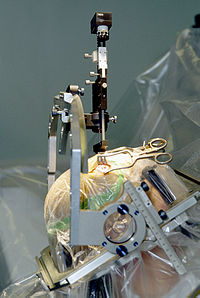
Photo from wikipedia
BACKGROUND Surgery for thoracic disc herniation and stenosis is comparatively rare and often demanding. The goal is to achieve sufficient decompression without manipulating the spinal cord and to minimize surgical… Click to show full abstract
BACKGROUND Surgery for thoracic disc herniation and stenosis is comparatively rare and often demanding. The goal is to achieve sufficient decompression without manipulating the spinal cord and to minimize surgical trauma and its consequences. Individual planning and various surgical techniques and approaches are required. The key factors for selecting the technique are anatomical location, consistency of the pathology, general condition of the patient, and the surgeon's experience. OBJECTIVES The objective of the study was the evaluation of the technical implementation and outcomes of a full-endoscopic uniportal technique via the extraforaminal approach in patients with symptomatic soft or calcified disc herniation of the thoracic spine, taking specific advantages and disadvantages and literature into consideration. STUDY DESIGN Retrospective study. SETTING A center for spine surgery and pain medicine. METHODS Between 2009 and 2015, decompression was performed on 26 patients with thoracic disc herniation or stenosis with radicular or myelopathic symptoms in a full-endoscopic uniportal technique with an extraforaminal approach. No patients underwent additional posterior stabilization. Imaging and clinical data were collected in follow-up examinations for 18 months. RESULTS Sufficient decompression was achieved in the full-endoscopic uniportal technique in all cases. The individual selection of the respective approach made it possible to reach the target area without manipulating the spinal cord. One patient experienced deterioration of a myelopathy. No other serious complications were observed. All patients, except one, experienced regression or improvement of symptoms. No evidence of increasing instability was found in imaging. LIMITATIONS This is a retrospective study. The limited number of cases must be considered. CONCLUSIONS The full-endoscopic uniportal technique with an extraforaminal approach was found to be a sufficient and minimally invasive method with the known advantages of an endoscopic procedure under continuous irrigation for monosegmental disc herniations. The inclusion criteria must be taken into consideration. If they are not met, an alternative full-endoscopic approach (interlaminar, transthoracic retropleural) or decompression in a conventional method must be selected. Additional stabilization does not appear to be necessary due to the low level of trauma. KEY WORDS Extraforaminal approach, thoracic disc herniation, giant disc herniation, Full-endoscopic, minimally invasive, thoracic spine.
Journal Title: Pain physician
Year Published: 2018
Link to full text (if available)
Share on Social Media: Sign Up to like & get
recommendations!